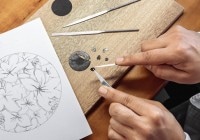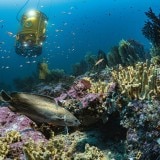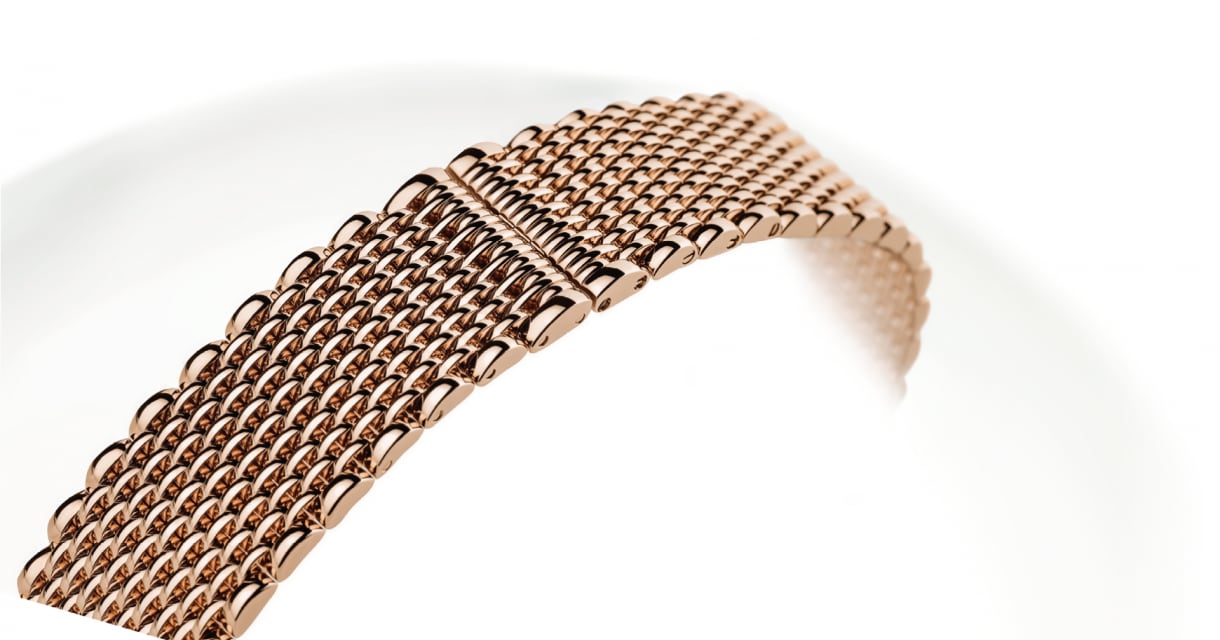
Search in Issues
Chapters
List of parts
Chapter 3
700 Sharks IN THE NIGHT
Shark instincts, ocean moments.
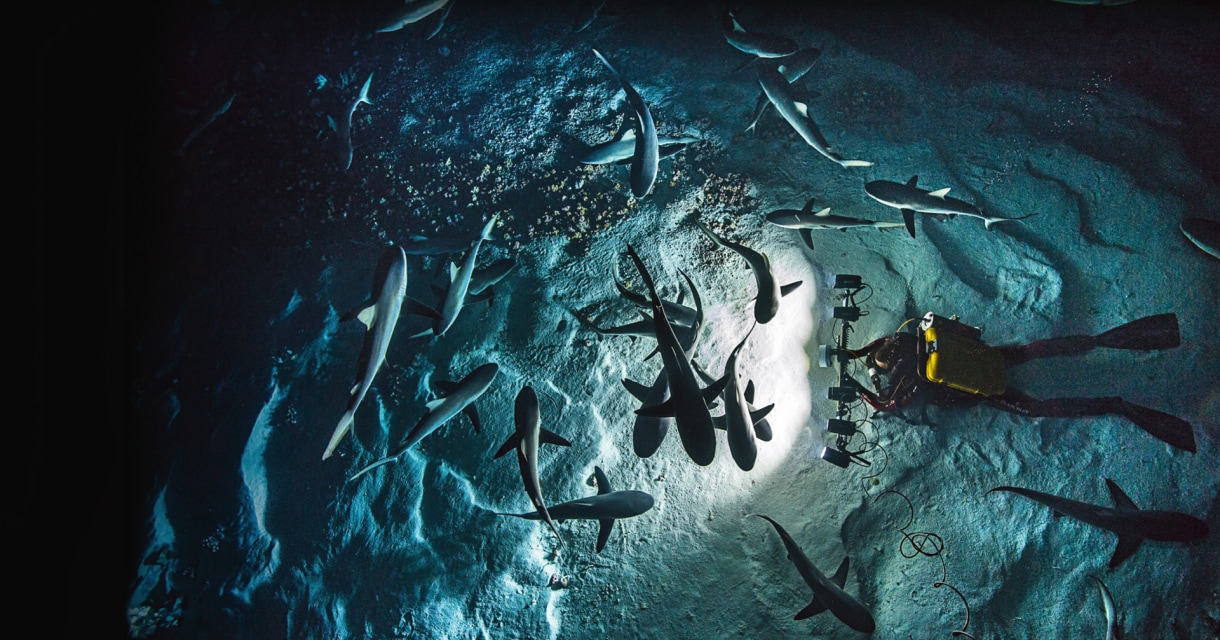
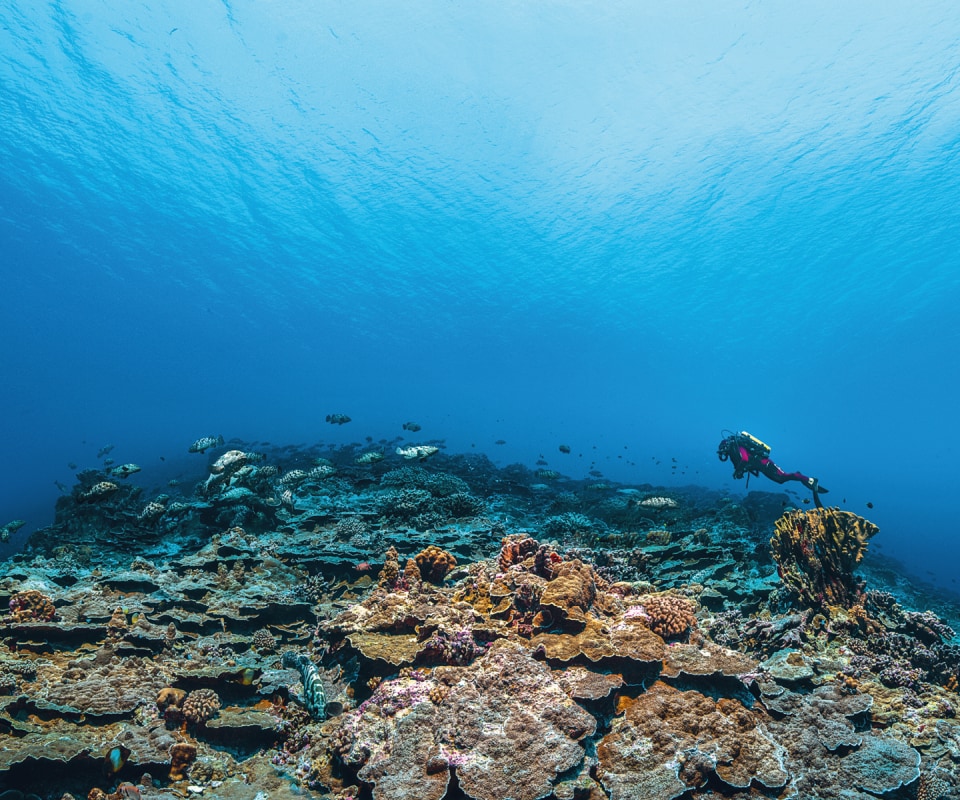
Cédric is resting on the bottom as the dive has been going on for a few hours. Every dive, he swims a couple of meters above me, fighting against the current, holding the heavy ramp especially made to hold my strobes. The cable links the strobes to my camera.
I dream of being free of artificial breathing apparatus, of not having to return to the surface and being able to wander around a wilderness.
I often have this daydream: I go off diving like a botanist heads for the forest, or a mountaineer to the mountain, with no concerns about lack of air or decompression accidents. I dream of being free of artificial breathing apparatus, of not having to return to the surface and being able to wander around a wilderness and soak it up without any time constraints. I dream of living my passion for the sea with a free mind, simply and without limits, to roam the valley of sharks and do it again; as if the adventure fed on routine… solve the mystery of the place… and even more importantly, keep those promises made during childhood.
We are back in the Southern Pass of the Fakarava Atoll. It is the fourth consecutive expedition we have undertaken here. In 2014, for the first time, I completed a 24-hour dive at 20m. I was determined, but in truth, I was hiding my excitement. I was afraid of being exhausted too quickly and having to abort the mission. It took me six hours of decompression stops made necessary by the 87% of helium that I was breathing. The stress of the first moments made me quite simply forget how lucky I was to be there. It is a unique place, as was the moment: the groupers were gathered in their thousands, here where the sharks would await them in their hundreds come nightfall. I was lucky to be amongst them, to be able to observe them for an entire day and night.
During the first expedition, we obtained the numbers resulting from our daily counts for the very first time: 18,000 groupers and 700 sharks, or the greatest density known to date for these two species. We repeated the exercise on every expedition in order to compare the data on the two populations.
Every year, the groupers live alone except for this time when they cohabit in their thousands, because in just a few days, those who have managed to escape the sharks will all breed simultaneously. After standing by underwater for dozens of hours, we intuitively feel we have understood at last the exact moment that breeding should take place. The past three years have left us with a sense of “failure”, that we arrived too late and missed the tail of the comet. Today, we are finally ready and on time, I think.

Those groupers who have managed to escape the sharks will all breed simultaneously.
In the midst of their wild races, we are obstacles, not targets.
We dive every night. By day, the sharks form three groups that we call the “walls”. These walls form in precise locations in the main current seams. Each time a shark leaves the current seam it is replaced, in the same way as birds do, in V-shaped flight formations during migrations. But at night, they leave the water column and patrol the bottom of the Pass. In 2014, we kept our distance. In a flash, the pack dive on the prey, and in the rush, reduce a coral reef to shreds. The spurt is incredible, and we, the spectators, are pinned to the spot by the stunning sight. The show sometimes demands abiding reverence: knees drawn up to one’s chest. The stress is admittedly ever-present, yet our eyes shine in the semi-darkness.
Year after year, dive after dive, a certain intuition develops: we won’t be bitten. In the midst of their wild races, we are obstacles, not targets. Boosted by this knowledge, we draw closer and closer to them. In a move that would have been unthinkable the first year, we now actually enter the pack.
Yannick is under the ball of sharks. To what extent is their activity organized or improvised? At what point does it begin to be effective when they hunt together? There is undoubtedly an ideal number of sharks to form a pack. If there aren’t enough, the prey escapes, but if there are too many, the sharks have little chance of obtaining some of the spoils. While the group is a strength, it becomes a handicap when sharing is impossible. Can natural selection result in a generation of cooperants? The sharks would then be capable of avoiding the perils of stark individualism and pitiless competition.
Before our eyes, the 700-strong pack of sharks in action operate as a single gigantic individual endowed with 700 jaws. Conversely, the gray shark, isolated, is clumsy and inefficient. Its salvation lies in the pack, when they synchronize their action all together. I think one must forget the old cliché about uncontrolled frenzy. Our four years of observations and frozen frames lead us to believe the opposite. There may be far more coordination, organization and tactics than we imagined up till now…
The tide turns and we exit our dives at midnight… 2 o’clock… and even 4 o’clock in the morning, always on a high. Cédric is less confident: “If they bite each other, they are just as likely to bite us”; and “an involuntary bite won’t hurt less”. His off-the-cuff thoughts encourage caution, but weaken this intuition, which is becoming a conviction: we will never be bitten. Yet I barely dare say it…


While the sharks patrol the reef in search of food, this naso fish is hiding desperately. Usually uniform in color, they change shades when threatened.
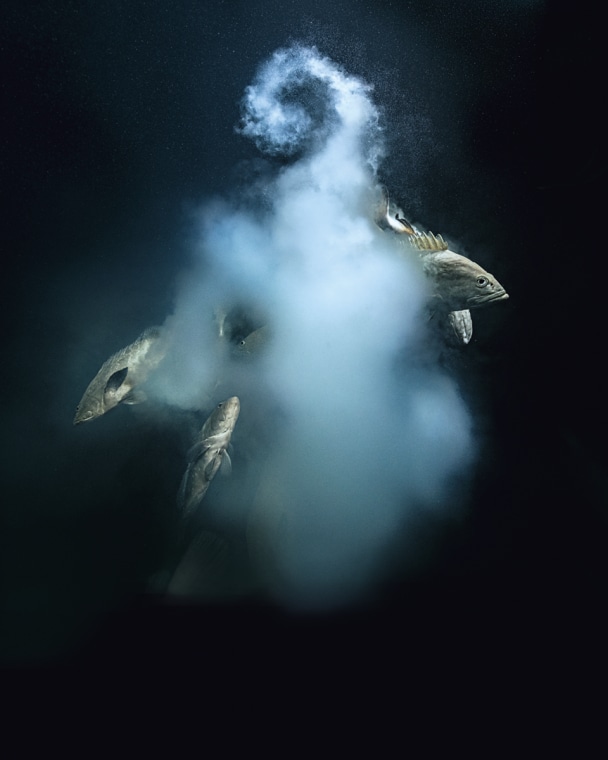
As the couple swims up for the female to release her eggs, opportunistic males quickly follow and release their semen, turning the water into a white, milky cloud. All this happens in less than half a second.
Finally. After three weeks of effort and risks, the battered female makes up her mind and leaps vertically, driven by the dominant male.
Then a brutal shock followed by tingling, different from the usual snout punches which sometimes cause bruises. I run my hand over the back of my thigh and realize that my wetsuit is torn. It’s bleeding and it requires four stitches. A shark bite? There go my convictions. Fortunately, two cameras filmed the scene: it wasn’t a shark but the scalpel tail of a large surgeonfish that sliced my skin. The shark was holding the fish in its mouth and shook it violently behind my leg. The assumption still holds: these sharks won’t bite us.
We continue the night dives and our questions persist: do our lights change the behavior of the sharks at night? They unquestionably attract them. Furthermore, do they provoke increased predation? There’s no certainty. With the same amount of light, the predations may be non-existent or non-stop. They tend to vary according to the lunar cycle period, or more simply put, between the beginning and the end of the night. On some sites no predations take place, even with all the light in the world.
The groupers live in terror. In the early morning, I catch myself wanting to show their painful existence by gathering together a tragic gallery of injuries, and drawing
a picture of the survivors who bear the wounds of the nocturnal raids.
The wounds are deep. Torn fins and mutilated bodies, yet nothing impedes their determination. Some scars are already a few years old. Their resilience is fascinating. They appear able to recover from anything, even a ripped jaw bone. Nothing counts apart from breeding soon, at all costs. These fish are not the masters of their own destiny, but slaves to their instinct.
During their large gathering, the groupers expend incredible energy. They fight, parade and woo without even stopping to eat. The females, stomachs enlarged by the eggs they are carrying, keep their camouflage dress. The males, on the other hand, have abandoned it. They are wearing the gray suits of serious business. They have agreed to the sacrifice, right now they want some rewards. The males bite the females. Breeding is imminent.
Finally. After three weeks of effort and risks, the battered female makes up her mind and leaps vertically, driven by the dominant male. She expels a thick cloud of eggs that he hurries to fertilize. He has to be quick to be the first because in the split second that follows, several opportunists converge on the couple. They in turn inundate the scene with their semen. Only frozen images make it possible to see this precedence of the dominant male, a slight lead that is hard won in the face of fierce rivalry. Three weeks of battles for the privilege of a fraction of a second.
Breeding is over, but we continue our night dives. The hunts are so quick that I often only discover them after the dive, once back on the ground. In the early morning, when I at last look at the images taken in the middle of the night, I have the feeling that I stole these moments during dives that until now were forbidden by caution, or ignorance. Sometimes one confuses
the two.
I hear the divers yelling under water when a stunning hunting scene is captured.
To gain a better understanding of these fascinating hunts, we developed a way to combine photo and video: the Image Arch. A spaceship flying in the aquatic sky. A science-fiction vision in the waters of Fakarava. The Arch crosses the Pass after having crossed our minds. The idea became a reality in a few months. The creation was laborious. Enthusiasm gave way to obstinacy and it was born. Now it just needs to provide us with the unprecedented images of our dreams.
The Image Arch is 4m in diameter and carries thirty-two small cameras spread at regular intervals. Up till now, this technique was reserved for film fiction, or analyzing a spectacular sports move. It’s a clever idea: freeze the image and then circle the scene thus frozen. The action must take place exactly in the center of the Arch, where the thirty-two cameras are pointing. It remains to be hoped that we will be able to use it with wild animals in the middle of a hunt.
After ten days of misery, Antonin and Tybo drive the Arch with great skill and the sequences come thick and fast. It is something like a fantasy film: the magician stops the clock and objects and people come to a standstill, and then it moves around at will in this frozen space. This is precisely what we want to achieve, but in the middle of the sharks. I hear the divers yelling under water when a stunning hunting scene is captured. For my part, I see the reconciliation of photography and film: stopping time, yet allowing free movement.
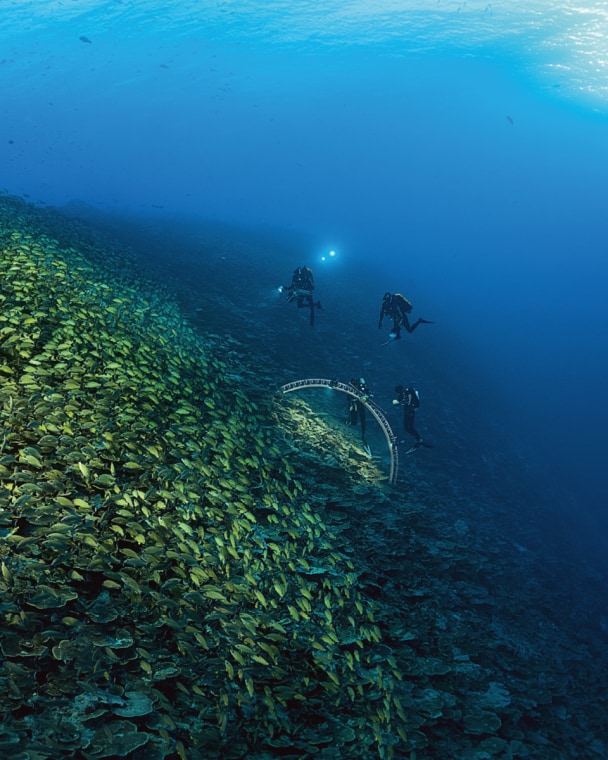
The team is running a first trial of the Image Arch with a gathering of yellow-margined snappers along the edge of the reef, just above the great depths surrounding the atoll.
The only issue that needs to be resolved is actually capturing the sharks.
The scientific team analyzes the videos (featuring 1,000 images/second) that we have been making since the first expedition. They help us to understand the different phases of an attack: firstly it is undoubtedly the noise that attracts the shark, while sight and motion are also important, but in the half-light, a shark has an additional asset: it can detect the electromagnetic fields that fish produce thanks to the sensitive cells it has all along its mouth, the ampullae of Lorenzini.
This year, we hope to monitor forty sharks to assess, amongst other things, their activity, their speed of movement, and to confirm hunts in pairs. In the long term this monitoring will allow us to record all their movement over a year. At the beginning of the mission, the team installed twenty-five acoustic receptors in the Pass for marking purposes. The only issue that needs to be resolved is actually capturing the sharks. Having already experienced it, I find hook and line fishing extremely violent. I decided to try a new method: grabbing the shark at the base of the tail and turning it over. It is a known technique: the shark falls into a state of catalepsy and can be handled. One second before, the over-excited shark was in the middle of a hunt. The next second, it is completely immobilized. This is how we are going to delicately bring forty gray sharks to the surface. The researchers, Johann, Charlie and Yannis, will operate on them and insert a small transmitter in the abdominal cavity, an insignificant operation for a shark that heals incredibly fast.
Tactical encirclement of prey by sharks, amorous acrobatics by the groupers. We are proud of all these images and yet they are but a tiny clarification of the huge Secrets of the Oceans. Can it be any other way? What can we know about these liquid expanses that occupy two-thirds of the globe? Worse: if we work out where life is possible in terms of volume, then the oceans represent around 95% of this planet so inappropriately named Earth. How can we think we know this Planet Seas, vast and deep, we poor primates devoid of gills?
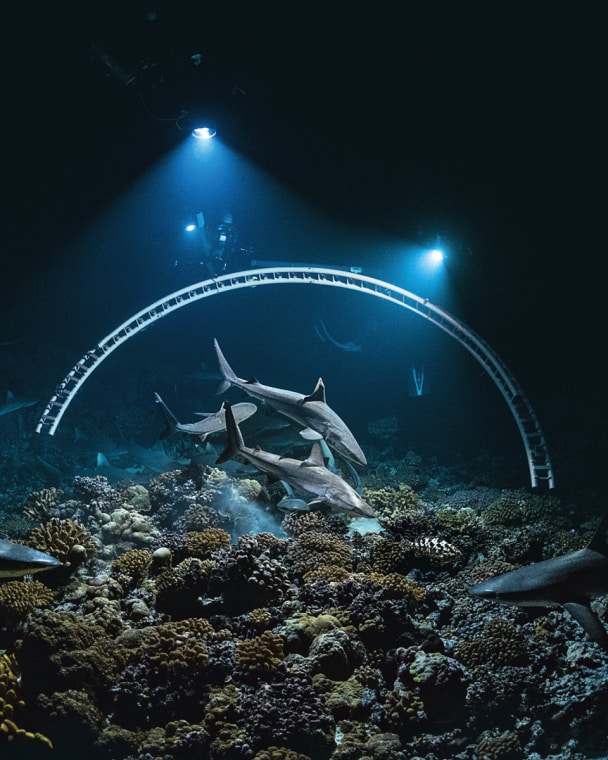
Tybo and Antonin positioning the Image Arch to capture the sharks catching a prey. Night after night, they dived with this bulky structure to film moments of predation that have never before been documented in this manner.
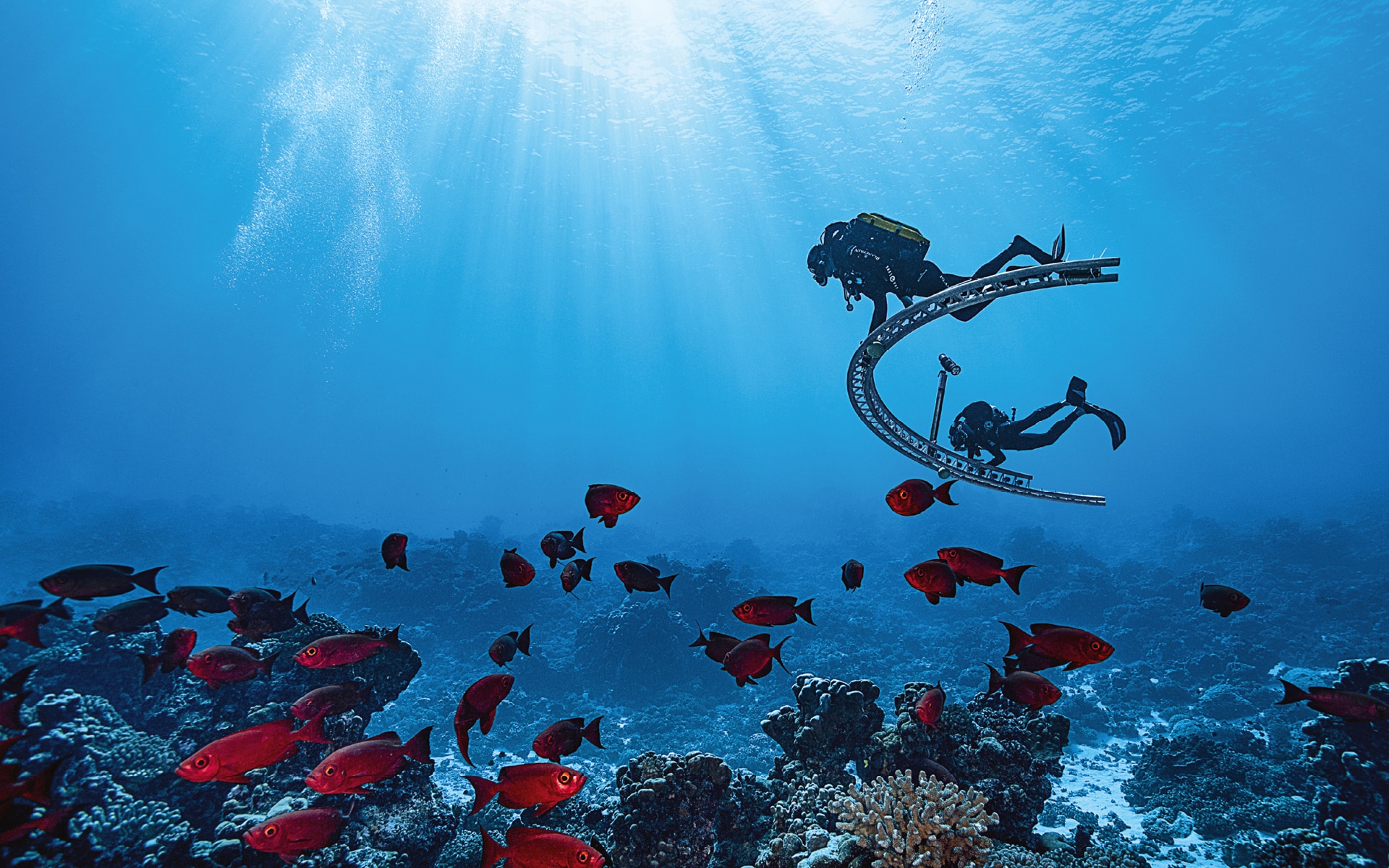
Recreating new routines in different places is perhaps the very definition of adventure.
For 21 weeks spread over four years, we dived every day and every night. Altogether, that makes around 3,000 hours under the surface, always in the same place. I loved this pleasant repetitive discipline as did my buddies, I think. Recreating new routines in different places is perhaps the very definition of adventure.
Observing is about seeking to explain reality; photography is attempting to enhance it. The scenes of hunting and spawning go so fast that they cannot be seen. So, albeit instinctive, taking shots is the only option left to fulfill the twin desires of understanding and contemplating. Eighty-five thousand shots in four trips in four years.
Since prehistoric times, men fascinated by the untamed world around them have felt this compelling need to illustrate. Formerly, cavemen and their rock paintings, today divers and their high-definition pictures. Isn’t that simply the continuation of the same pictorial tradition? Perhaps it’s the same tribute, through the ages, pathetic but reassuring, to the inexplicable beauty of nature.
Curiosity is not blunted under the water, but instead sharpened. The longer one dives, the greater the need to contemplate. The paradox of these thousands of hours of submersion required just to understand elusive pieces of wild life, shark instincts, fish urges… Unforgettable moments in the oceans. A desire to understand more. We will have to return.
The Tuamotu archipelago consists of 76 atolls spread over 1,600km. They do not appear on any map of the Pacific. These ghosts of ancient volcanoes are nonetheless very much alive. In my opinion, they are a range of mountains of which we are only familiar with the peaks. Deep diving becomes mountain climbing in reverse. In 2017, our boat went from peak to peak with, at each stage, the hope of a few negative ascensions.
One can see the atoll as a simple coral disk, completely flat, flush with the surface, or as a living crown settled on a rocky needle that is 2,000 m high. Depending on whether one’s gaze is land-based or under water, the coral atoll is a plant-bearing island or an animal which bears an island. Both visions are possible.
On the one hand, the noble undertaking of miniscule coral polyps that build the reef, and on the other, the forces of the ocean that destroy it. But if the coral builders had no constraints, the reef would be monolithic, smooth, devoid of relief, with little diversity. It would appear that building where there are no obstacles yields less gloriously radiant results.
One hundred and twenty meters under the sea, the walls we are exploring are vertiginous. One might be almost surprised that the deep is home to such troubled reliefs. It would mean that we had forgotten that 20,000 years ago, the sea was 120 m lower. What we see here is the remains of an ancient coastline battered by the waves and the swell of another era. Going down to the depths is akin to going back in time.
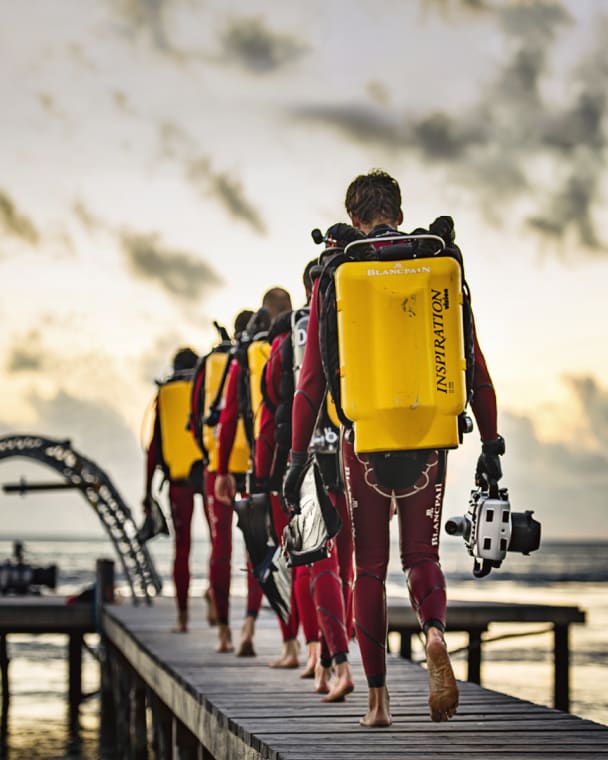
Intriguing white colors shine all along the dark walls.
Intriguing white colors shine all along the dark walls. The erosion of the reef near the surface causes these waterfalls of sand 100 m lower down. The cascades slowly follow deep vertical fissures. One might think that the tortured coral is weeping on the cheeks of the atoll and that tears of sand fall towards the depths.

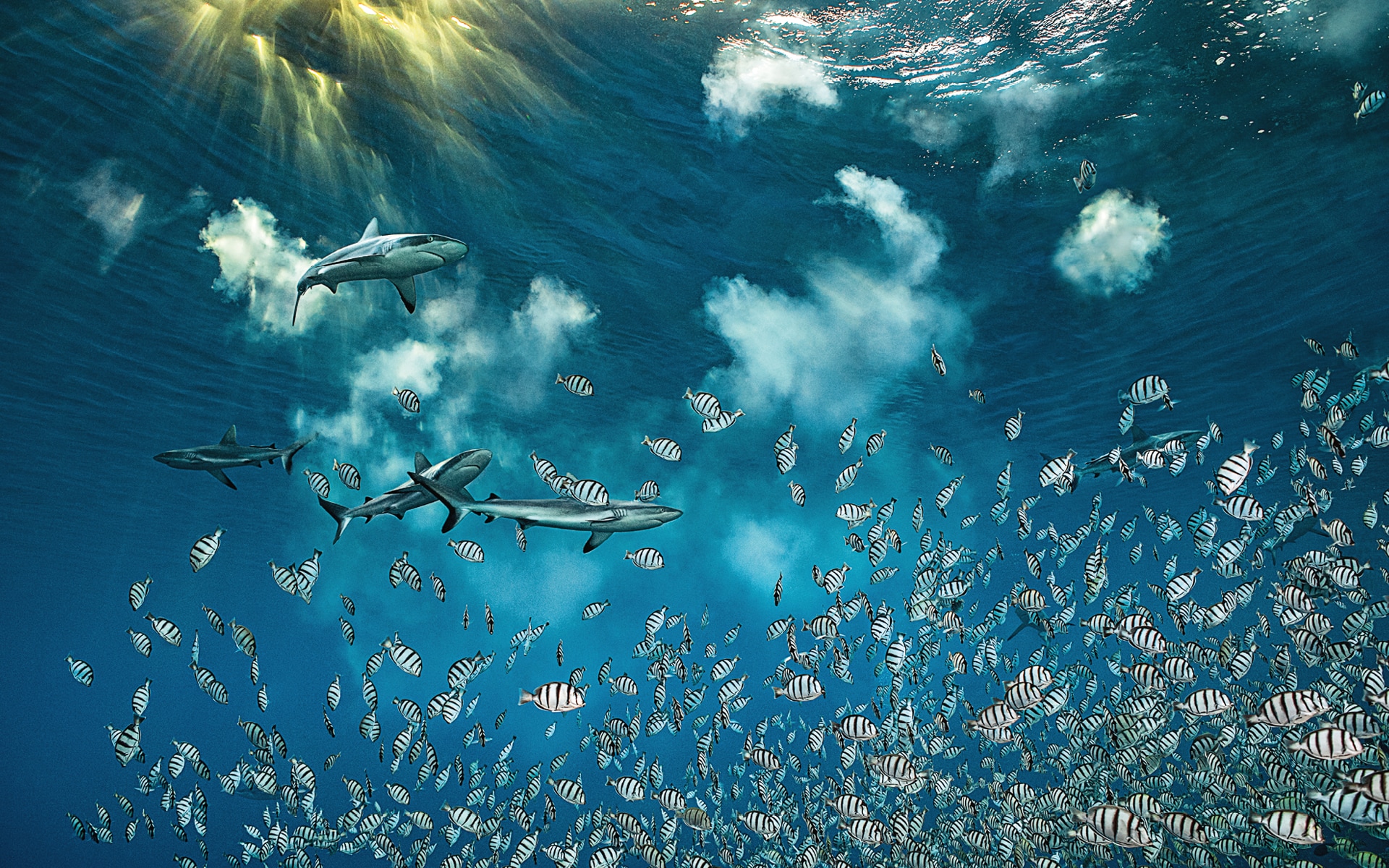
Very quickly, the first few meters are scattered with little clouds that evaporate in the milky water.
Whether full or dark, the moon guides the gatherings in the Pass. Unlike the groupers, the Convict Surgeonfish, known locally as “Manini” gather to mate every fortnight. Before sunset, they ascend the sides of the Pass Indian file and find a place that suits them.
This is not always the same place and the number of fishes also varies. It took the groupers three weeks to gather, while it only takes half an hour for small fish that have neither territory nor females to defend. We are in just a few meters of water and, like with the groupers, we await the big moment. In a common impetus, they launch themselves in small groups towards the surface and release their seed. The sharks try to take advantage but oft in vain. Very quickly, the first few meters are scattered with little clouds that evaporate in the milky water. About 20 minutes later, the “Manini” turn around and return to the lagoon. •

The “Manini”, small surgeon fish, gather every two weeks, at sunset, to reproduce in the shallow waters of the Pass. Followed by the sharks, they rely on their agility to escape the hungry jaws.


